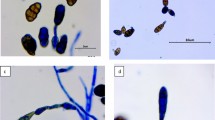Abstract
Leaf blight disease was found on Gloriosa superba L. (Liliaceae), an endangered, herbaceous, perennial, climbing lily that produces colchicine, in West Bengal, India in 2004. Small brownish spots on leaves developed into concentric rings, which eventually darkened and coalesced to blight the entire leaf. The causal fungus was morphologically identified as Alternaria alternata (Fr.) Keissler. This is the first record of A. alternata on G. superba.
Similar content being viewed by others
Avoid common mistakes on your manuscript.
Introduction
Gloriosa superba L. (glory lily, Liliacea) is an endangered, herbaceous, perennial, climbing medicinal plant found throughout India. Colchicine is the major compound isolated from the seed and rhizome of this plant (Sarin et al. 1974). It has abortifacient, anti-pyretic, anti-inflammatory and anti-leprotic properties (Guhabakshi et al. 2001). A leaf blight disease of this plant was observed during 2004–2006 in different areas of lower Gangetic plains of West Bengal, India. Recorded losses were estimated to be 65–80% per annum.
Symptoms
A leaf blight disease of this plant was observed during June to September (temperature 31 ± 2°C). Early symptoms appeared as small, circular to oval, light brownish spots (25–38 mm), 2–6 per leaf, scattered at the tip, margin, and midrib of the leaves. Subsequently, the spots enlarged and usually developed into a concentric ring. At an advanced stage, the spots became dark brown to blackish in colour, gradually coalesced and became irregular in shape, then the affected leaf blighted completely (Fig. 1a–c).
a Leaf blight disease of Glory lily (Gloriosa superba L.) at an advanced stage, naturally infected with Alternaria alternata. b Close-up of a naturally infected leaf with clear concentric rings. c Blighted leaf at advanced stage. d 72 h old colony of A. alternata on PDA. e Mycelia and conidia of A. alternata isolated from a leaf lesion. Bar = 25 μm
Identification of the pathogen
A fungus was consistently isolated from the blighted leaf on potato dextrose agar (PDA) as a pure culture (Fig. 1d). The fungus produced abundant branched, brownish, septate mycelia; conidia were found on leaf peels and scrapings, in cleared leaves and in vertical sections of leaves. Conidial size varied from 17.5–52.5 × 8.5–16 μm, with 3–5 transverse septa (Fig. 1e). Characteristics of conidia from cultures were similar to those of conidia isolated from infected plants. Based on the morphological characters, the organism was identified as Alternaria alternata (Fr.) Keissler (Ellis 1971), and the identification was confirmed by the Agharkar Research Institute, Pune, India.
Pathogenicity test
Leaf disks (14 mm) were surface sterilized (0.5% sodium hypochlorite for 2 min), then placed on 0.5% water agar containing 1 μg/ml of benzylaminopurine (Ash and Lanoiselet 2001). They were then inoculated with 10 μl of a conidial suspension (104 conidia/ml sterile distilled water). A control leaf disk was inoculated with sterile distilled water. The leaves were incubated at 25°C for 4–5 days. After 5 days, typical target spot symptoms developed on the inoculated disks. A. alternata was reisolated from such disks.
References
Ash GJ, Lanoiselet VM (2001) First report of Alternaria alternata causing late blight of pistachio (Pistacia vera) in Australia. Plant Pathol 50:803
Ellis MB (1971) Dematiaceous Hyphomycetes. Commonwealth Mycological Institute, Kew
Guhabakshi DN, Sensharma P, Paul DC (2001) In: A lexicon of medicinal plants in India. Naya Prakash, Calcutta, vol. 2. pp 262–264
Sarin YK, Jamwal PS, Gupta BK, Atal CK (1974) Colchicine from the seeds of Gloriosa superba. Curr Sci 43:87–90
Acknowledgments
Authors are thankful to the Ramakrishna Mission Ashrama, Narendrapur, India for providing facilities to perform field experiments in their Medicinal Plant Garden and to the Directorate of Food Processing Industries and Horticulture, Govt. of West Bengal, India for financial assistance.
Author information
Authors and Affiliations
Corresponding author
Rights and permissions
About this article
Cite this article
Maiti, C.K., Sen, S., Paul, A.K. et al. First report of leaf blight disease of Gloriosa superba L. caused by Alternaria alternata (Fr.) Keissler in India. J Gen Plant Pathol 73, 377–378 (2007). https://doi.org/10.1007/s10327-007-0033-9
Received:
Accepted:
Published:
Issue Date:
DOI: https://doi.org/10.1007/s10327-007-0033-9





